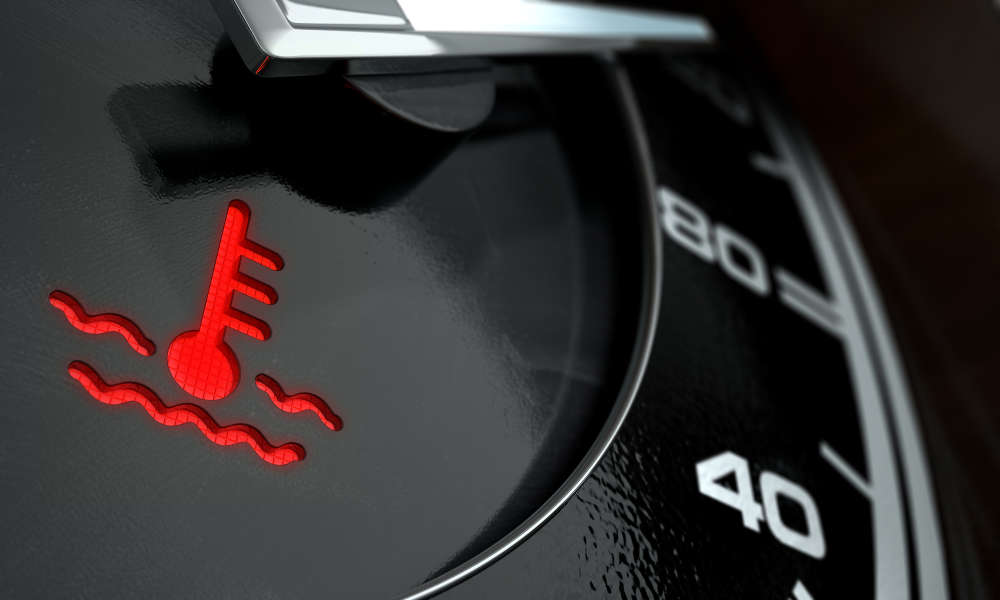Enjoying a lovely day and a perfect ride, and out of nowhere, you see your beautiful Porsche Boxster smoking from under the hood?
Well, that can’t be nice. Numerous things can be the root of the problem.
But, the good thing is that you are here, reading about how to fix the problem and not driving!
In this article, you will find out what can cause your temperature light warning and how to fix it. Also, read about what you can do to prevent it and which items you should avoid!
Advertising links are marked with *. We receive a small commission on sales, nothing changes for you.
What Does The Signal Means?

This temperature warning light means your engine is overheated or operating at an extremely high temperature.
If your car has a functional and proper cooling system, that could never happen.
However, a faulty cooling system or insufficient coolant can cause the engine to overheat, resulting in engine damage.
Overheating engines can occur because of several circumstances. And one of those circumstances is a cooling system.
The problem might be caused by:
- cooling system leak,
- a broken radiator fan,
- a damaged water pump, or
- a coolant pipe that is clogged.
Regardless of the cause, an overheated engine is not something you want to ignore. Your engine may endure significant, if not permanent, damage.
For What Signs Should I Look For If My System Is Overheating?
You can lessen the chance of permanent engine damage if you chill your motor before it gets too hot to the failure point.
But first, you must recognize the signs of overheating, which include:
- Steam (which can resemble smoke) is coming from behind the hood.
- A dashboard engine temperature indicator spikes to “H” or into the red. (Be sure to check your owner’s handbook for specific engine temperature gauge symbols.)
- A peculiar odor emanates from the engine compartment. Leaking coolant, for example, may smell pleasant, but leaking oil may smell charred.
- Take the following procedures as soon as you realize the engine is overheating and contact your local repair shop.
What Can I Do To Fix It?
There are two major categories when it comes to dealing with the causes of your engine temperature warning light turning on:
- Repairs that you should delegate to your mechanic
- Maintenance that you can perform yourself
You generally won’t feel secure handling most technical issues that might cause the light unless you’re an experienced automotive do-it-yourselfer.
A mechanic’s skill in dealing with different cooling system difficulties and related concerns may be relied upon.
However, a few simple items of ordinary auto care will preserve your cooling system running. Well, until a mechanical component malfunction or wears out.
Here’s a rundown:
- Routinely monitor your coolant level and replenish as needed. Then, use the correct sort of coolant and mix it with water.
- Get your cooling system repaired or flushed according to the manufacturer’s recommendations.
- Routinely monitor your oil and other fluids, filling up and replacing them as needed.
- Maintain your car at the appropriate intervals.
Have your mechanic examine your temperature gauge straight away if it starts reading greater than average. It might be an early warning indication of an ongoing issue that can be addressed.
What Should You Avoid Doing If The Temperature Light Pops?
First and foremost – do not freak out. That way, you won’t help either yourself or your metal pet.
Your engine is overheating, but it is not like you can’t do anything.
If you are in the middle of the trip, carefully drive until you find a safe sport for your car. Do not drive more than a few kilometers.
You will risk getting your car’s machine damaged.
You may think that it is okay to drive because, well, your car still drives, but it won’t do you any good.
Pushing your engine too hard can result in various damages.
And that will cause damage to your wallet.
Make sure you don’t swerve across traffic or put a lot of pressure on the brakes. The brakes will exhaust your machine, and it will overheat more quickly.
After you reach the destination, wait a couple of minutes before popping open the hood.
If you open the hood too early, you might get burns on your face from the smoke and the steam.
So it is best if you wait for, let’s say, fifteen minutes before you open it.
Be patient, your car is already here, and some damage is already done.
Okay, the fifteen minutes have passed, and now you need to put some coolant inside.
Once you do it, you can continue your drive, but be careful. Do not exhaust your car because the problem is still there.
If you want to save your car, you have to get to the bottom of the problem.
Conclusion
Hopefully, you found the information you’ve been looking for.
When our car overheats, there is so much we can do. You can take it to the mechanic shop or try to look at it by yourself.
Both options are okay, but be sure not to exhaust your machine after the light is on.
If you know your car is already seriously damaged, driving to the mechanic is not optional.
Contact them and ask them to come and get your vehicle.
Of course, you will have to pay a fee, but that is better than burning your car’s machine to the point where it’s not even an option to save it.

Luna Meschiari is a full-blooded car nut who is well known to local garages, as each article is meticulously researched and peppered with the latest piece of information. Guess what car she’s driving right now? A RAV4 2021 Hybrid. But her heart also sleeps for pickups like the F-150. Get to know Luna better on the about us page.
Advertising links are marked with *. We receive a small commission on sales, nothing changes for you.
